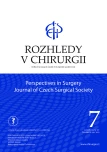Microbiological analysis of peritoneal fluid samples from patients with perforated peptic ulcer – retrospective observational study
Authors:
J. Ulrych 1; V. Adámková 2; M. Hostačná 1
Authors‘ workplace:
I. chirurgická klinika – hrudní, břišní a úrazové chirurgie, Všeobecná fakultní nemocnice a 1. lékařská fakulta Univerzity Karlovy v Praze
1; Klinická mikrobiologie a ATB centrum, Ústav lékařské biochemie a laboratorní diagnostiky, Všeobecná fakultní nemocnice, Praha
2
Published in:
Rozhl. Chir., 2022, roč. 101, č. 7, s. 312-317.
Category:
Original articles
doi:
https://doi.org/10.33699/PIS.2022.101.7.312–317
Overview
Introduction: Peritonitis due to perforated peptic ulcer (PPU) is a surgical emergency associated with high mortality. Preoperative management includes immediate initiation of broad-spectrum antimicrobial therapy. The objective of this study was to assess the spectrum of microbial pathogens in peritoneal fluid.
Methods: Retrospective observational study of patients who underwent surgery for PPU at the 1st Department of Surgery – Thoracic, Abdominal and Injury Surgery, General University Hospital in the period 2015–2020. Analysis of the microbiological analytical results of peritoneal fluid.
Results: The microbiological profile of PPU-associated peritonitis is somewhat different from microbial pathogens involved in secondary peritonitis due to bowel perforation. A high rate of negative culture findings, high incidence of Candida spp. and low incidence of anaerobic bacteria are characteristic for PPU-associated peritonitis. Negative culture from the peritoneal fluid collected during surgery was identified in 42% of the patients. A total of 66 isolates of microbial pathogens were identified, including Candida spp. (42.5%), aerobic gram-positive bacteria (30.3%), aerobic gram-negative bacteria (22.7%) and anaerobic bacteria (4.5%). Candida albicans and Candida glabrata represented the most common species. Decreased susceptibility to fluconazole and resistance to itraconazole was associated with all Candida glabrata isolates.
Conclusion: Although PPU-associated peritonitis is mostly of community origin, we confirmed a significant incidence of Candida spp. with decreased azole susceptibility. The choice of antifungal therapy should always be based on local epidemiology.
Keywords:
antifungal susceptibility – antifungal therapy – perforated peptic ulcer – Candida spp.
Sources
1. Chung KT, Shelat VG. Perforated peptic ulcer – an update. World J Gastrointest Surg. 2017;9(1):1–12. doi:10.4240/wjgs. v9.i1.1.
2. Xie X, Ren K, Zhou Z, et al. The global, regional and national burden of peptic ulcer disease from 1990 to 2019: a population- based study. BMC Gastroenterol. 2022;22(1):58. doi:10.1186/s12876-022- 02130-2.
3. Weledji EP. An Overview of gastroduodenal perforation. Front Surg. 2020;7:573901. doi:10.3389/ fsurg.2020.573901.
4. Tarasconi A, Coccolini F, Biffl WL, et al. Perforated and bleeding peptic ulcer: WSES guidelines. World J Emerg Surg. 2020;15:3. doi:10.1186/s13017-019- 0283-9.
5. Sartelli M, Chichom-Mefire A, Labricciosa FM, et al. The management of intra- abdominal infections from a global perspective: 2017 WSES guidelines for management of intra-abdominal infections. World J Emerg Surg. 2017;12:29. doi:10.1186/s13017-017-0141-6.
6. Sartelli M, Coccolini F, Kluger Y, et al. WSES/GAIS/SIS-E/WSIS/AAST global clinical pathways for patients with intra-abdominal infections. World J Emerg Surg. 2021;16(1):49. doi:10.1186/s13017-021- 00387-8.
7. Solomkin JS, Mazuski JE, Bradley JS, et al. Diagnosis and management of complicated intra-abdominal infection in adults and children: guidelines by the Surgical Infection Society and the Infectious Diseases Society of America. Clin Infect Dis. 2010;50(2):133–164. doi:10.1086/649554.
8. Sartelli M, Viale P, Catena F, et al. 2013 WSES guidelines for management of intra- abdominal infections. World J Emerg Surg. 2013;8(1):3. doi:10.1186/1749- 7922-8-3.
9. Mazuski JE, Tessier JM, May AK, et al. The Surgical Infection Society revised guidelines on the management of intra- abdominal infection. Surg Infect. (Larchmt) 2017;18(1):1–76. doi:10.1089/ sur.2016.261.
10. Gowda DB, Kadambari D, Vijayakumar C, et al. A clinico-microbiological profile in patients with perforated peptic ulcer with special reference to anaerobic organisms: a descriptive study. Int Surg J. 2017;4:1–6. doi:http://dx.doi.org/10.18203/2349- 2902.isj20164301.
11. Punamiya AR, Chougule PG, Ahuja B, et al. Commonest organisms and antibiotic sensitivity in peritonitis due to duodenal ulcer perforation in Krishna Hospital, Karad. International Journal of Health Sciences and Research. 2014;4:93–97.
12. Ravisankar J, Venkatesan VS. A study on peritoneal fluid culture and its antibiotic sensitivity in perforative peritonitis cases. IOSR Journal of Dental and Medical Sciences.2017:16(03):34–37. doi:10.9790/0853-1603133437.
13. de Ruiter J, Weel J, Manusama E, et al. The epidemiology of intra-abdominal flora in critically ill patients with secondary and tertiary abdominal sepsis. Infection 2009;37(6):522–7. doi:10.1007/s15010- 009-8249-6.
14. Jindal N, Arora S, Pathania S. Fungal culture positivity in patients with perforation peritonitis. J Clin Diagn Res. 2015;9(6):DC01–3. doi:10.7860/ JCDR/2015/13189.6050.
15. van de Veerdonk FL, Kullberg BJ, Netea MG. Pathogenesis of invasive candidiasis. Curr Opin Crit Care 2010;16:453e459.
16. Sartelli M, Catena F, Abu-Zidan FM, et al. Management of intra-abdominal infections: recommendations by the WSES 2016 consensus conference. World J Emerg Surg. 2017;12:22. doi:10.1186/ s13017-017-0132-7.
17. Montravers P, Dupont H, Gauzit R, et al. Candida as a risk factor for mortality in peritonitis. Crit Care Med. 2006;34(3):646–652. doi:10.1097/01. CCM.0000201889.39443.D2.
18. Pfaller MA, Diekema DJ, Gibbs DL, et al. Results from the ARTEMIS DISK Global Antifungal Surveillance Study, 1997 to 2007: a 10.5-year analysis of susceptibilities of candida species to fluconazole and voriconazole as determined by CLSI standardized disk diffusion. J Clin Microbiol. 2010;48(4):1366–1377.
19. Bassetti M, Vena A, Giacobbe DR, et al. Risk factors for intra-abdominal candidiasis in intensive care units: Results from EUCANDICU study. Infect Dis Ther. 2022 Feb 19. doi: 10.1007/s40121-021-00585-6.
20. Ulrych J, Adámková V, Matek J, et al. Intra- abdominal candidiasis in surgical intensive care unit – epidemiology characteristics and trends. Epidemiol Mikrobiol Imunol. 2020;69(2):57–63. English. PMID: 32819104.
21. Huston JM, Kreiner L, Ho VP, et al. Role of empiric anti-fungal therapy in the treatment of perforated peptic ulcer disease: Review of the evidence and future directions. Surg Infect (Larchmt), 2019;20(8):593–600.
22. Gürlich R, Adámková V, Ulrych J, a kol. Základní principy diagnostiky a léčby sekundární peritonitidy – doporučení odborníků s podporou SIS. Rozhl Chir. 2014;93(6):334–48,350–352.
Labels
Surgery Orthopaedics Trauma surgeryArticle was published in
Perspectives in Surgery

2022 Issue 7
Most read in this issue
- Diagnosis and treatment of surgical skin and soft tissue infections – current status
- Giant aggressive intra-abdominal desmoid-type fibromatosis – case report
- Laparoscopic repair of perforated peptic ulcer – routine procedure or targeted patient selection?
- Benign stenosis of common bile duct after Roux Y gastrectomy
